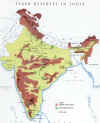| the-south-asian.com AUGUST 2001 | ||
| about us contact us data bank past issues the craft shop the print gallery | ||
|
SOCIETY & CULTURE Traditional
societies - Wisdom and Challenges SOUTH ASIAN FEATURE Hands
Across Borders INTERVIEW
Shantiniketan
and origin of Modern Art
Reinventing
India
Royal
Bengal's last roar?
|
Crouching Tigers, Hidden Dangers Text by Dev Duggal The Royal Bengal TigerTiger, the arrogant and proud king of the jungle, whose realm was unchallenged even by the likes of Alexander, Changez Khan and Tamur Lane, fell prey, first to the greed of hunters in quest of ‘trophies’, then to the mercenary poachers – who traded every organ of the tiger for money, and most recently to ‘planned development’ encroaching on tiger territory. A hundred years ago there were over 100,000 tigers – today there are perhaps fewer than 5,000 – 95% have been wiped out. Of these 5,000 about 3500 are hiding in India – in scattered pockets called Reserves - and the remaining in Bangladesh. In the 1970s, when the environmental alarm bells rang, there was nervous activity to do something about the situation – Tiger Reserves and Project Tiger were hastily set up – with committed environmentalists heading the schemes – but things did not come under control. Poachers reigned as they still they do. Environmental consciousness is not the rule, as yet, in south Asia. Tigers need space – they are not exactly condominium or apartment loving species. They are loners, and their beat may be anything from 50 to100 square miles of territory per tiger. It is this territory that is at risk of being taken over. Deforestation has shrunk the habitat of tigers. The small villages and hamlets that exist on the periphery of forests have no mega designs on the forest – village folk do not normally venture into tigerland – if they do it is only to collect firewood or seasonal berries. It is the Big Boys who have their eyes on the trees and the poachers who entrap and ensnare villagers and tigers alike. It is estimated that at least one tiger is slaughtered every day. The Indo-Tibetan and Nepal-Tibetan borders are the ‘Poaching Trails’ from where the remains of this once mighty ‘Lord’ find their way into the list of active ingredients of Chinese medicines (China having wiped out its own tiger population). Wonder what their famous ‘Tiger Balm’ is made of!! Picture of ultimate humiliation - in Taiwan(Courtesy: website of The Realm of India's Wild & Endangered Royal Bengal Tiger) In recent years much of the former tiger territory has been opened to ‘development’- to be blessed by the magic wand of an ‘open economy’. According to Bittu Sahgal, a long-time tiger activist and editor of India's largest wildlife magazine, Sanctuary: "Were poaching and population the limit of the problem, I would say the tiger could be saved through a combination of education, protection and consultation with communities. Unfortunately, industrialists and international bureaucrats are developing the tiger out of existence." The Kotku Dam project in Bihar will wipe out the Palamau tiger reserve. The ‘Forestry Project’ in Andhra Pradesh aims to replace the old forest trees with the commercial variety of eucalyptus, teak and bamboo – an outright commercial venture that has no room for tigers. The Hazaribagh National Park is at the risk of being trespassed by Coal India who may want to open more than 400 mines in the region. L-R: Man the Hunter-legacy of The Raj (Courtesy:Smithsonian Institution, Freer Gallery of Art and Arthur M. Sackler Gallery Archives); a private 'Hall of TigerSkin' in India (received from a reader- source unknown - our thanks and gratitude to the photographer)The first wave of large scale tiger slaughter came with the British Raj in the form of a ‘hunting sport’– the local Rajahs and Maharajahs also accelerated the process by organising shoots for the visitors – there are many a palaces that display ‘Tiger Rooms’ – tiger-skin rugs, tiger-skin wall hangings, stuffed tigers, tiger-skin upholstery, tiger all! Man the Hunter predisposeth all!
Tiger Facts
at the brink of extinction – may be extinct by the year 2010 – the Year of the Tiger! there were eight subspecies in 1900, there are only five now three sub-species of tiger were driven into extinction, including the Bali, Javan, and Caspian the last Javan tiger was seen in 1981 today there are less than 50 Siberian tigers there are 22 Tiger Reserves in India Map of Tiger Reserves in India Courtesy: website of The Realm of India's Wild & Endangered Royal Bengal Tiger
Information for the article
was sought from several sources, including 'The Realm of India's Wild &
Endangered Royal Bengal Tiger'
Copyright © 2000 - 2001 [the-south-asian.com]. Intellectual Property. All rights reserved. |
|




